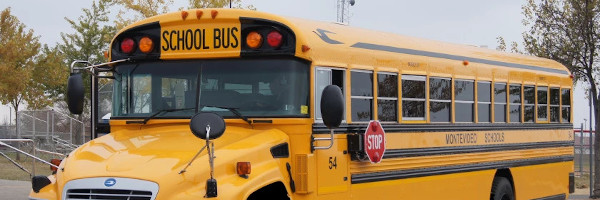Availability of Connectivity via WiFi: Difference between revisions
No edit summary |
No edit summary |
||
| (13 intermediate revisions by the same user not shown) | |||
| Line 1: | Line 1: | ||
{{COVID-19 | {{COVID-19 | ||
| title = Availability of Wi-Fi Connectivity | | title = Availability of Wi-Fi Connectivity | ||
| team = | | team = Wireless, Connectivity COVID-19 Task Force | ||
| leader = Benny Lee, David Witkowski | |||
| leader = | | image = SchoolBusHotspot.jpg | ||
| imagecaption = School Buses Become Wi-Fi Hot Spots | |||
| image = | | municipalities = San Leandro CA, San Mateo CA, Arizona, Arkansas, Georgia, Maine, Mississippi, North Carolina, Ohio, New Jersey, Vermont, Wisconsin | ||
| imagecaption = | | contributors = Benny Lee, David Witkowski | ||
| municipalities = | | chapter = Communications Networks | ||
| contributors = | |||
| website = | | website = | ||
| download = | | download = | ||
| description = | | description = | ||
During the COVID-19 pandemic some local governments and companies have made progress through publishing online and through physical postings to map WiFi Hotspots. | |||
}} | |||
=Publication of Wi-Fi sites= | =Publication of Wi-Fi sites= | ||
The lists and URLs below provide excellent examples of online and printable maps of Wi-Fi site facilities. Local governments can quickly compile these maps with an inhouse GIS mapping service or even leverage Google Maps / Google Earth to produce maps with locations within their jurisdictions. | The lists and URLs below provide excellent examples of online and printable maps of Wi-Fi site facilities. Local governments can quickly compile these maps with an inhouse GIS mapping service or even leverage Google Maps / Google Earth to produce maps with locations within their jurisdictions. | ||
* '''Local government publication of GIS maps of Wi-Fi sites''' | * '''Local government publication of GIS maps of Wi-Fi sites''' | ||
** [http://www.geosl.org/datasets/wifiber City of San Leandro] | ** [http://www.geosl.org/datasets/wifiber City of San Leandro WiFiber] | ||
** [https://www.smcgov.org/smc-public-wifi-project County of San Mateo | ** [https://www.smcgov.org/smc-public-wifi-project County of San Mateo WiFi Project] | ||
* '''Statewide publication of GIS maps of Wi-Fi sites''' | * '''Statewide publication of GIS maps of Wi-Fi sites''' | ||
** [https://www.google.com/maps/d/viewer?mid=11feN2l_3zrnUZCy03ezNs1o06fVZbfs0&usp=sharing Arizona] | ** [https://www.google.com/maps/d/viewer?mid=11feN2l_3zrnUZCy03ezNs1o06fVZbfs0&usp=sharing Arizona] | ||
| Line 37: | Line 33: | ||
** [https://hotspots.wifi.xfinity.com/ Xfinity] | ** [https://hotspots.wifi.xfinity.com/ Xfinity] | ||
* '''National Organizations with Hotspot listings''' | * '''National Organizations with Hotspot listings''' | ||
** [ | ** [https://www.digitalinclusion.org/covid19/ National Digital Inclusion Alliance COVID-19 ISP Resources] | ||
* '''Notes''': | * '''Notes''': | ||
** '''Caveat on Public Wi-Fi''': Most of these networks are open SSID, and should be considered insecure. Open SSIDs are also subject to “man in the middle” attacks. End-to-end or end-to-server encryption (VPN, SSH, etc.) is needed for use on open SSID networks, but this is beyond the skill set of most end users. Education about safe open Wi-Fi use is needed. | ** '''Caveat on Public Wi-Fi''': Most of these networks are open SSID, and should be considered insecure. Open SSIDs are also subject to “man in the middle” attacks. End-to-end or end-to-server encryption (VPN, SSH, etc.) is needed for use on open SSID networks, but this is beyond the skill set of most end users. Education about safe open Wi-Fi use is needed. | ||
| Line 68: | Line 64: | ||
**** [https://www.govtech.com/education/k-12/School-Buses-Become-WiFi-Hot-Spots.html South Carolina] | **** [https://www.govtech.com/education/k-12/School-Buses-Become-WiFi-Hot-Spots.html South Carolina] | ||
*** [https://www.vice.com/en_us/article/z3b54j/libraries-want-to-turn-bookmobiles-into-free-wifi-trucks-during-coronavirus-lockdown Library responsive model, using Bookmobiles outfitted with Wi-Fi] | *** [https://www.vice.com/en_us/article/z3b54j/libraries-want-to-turn-bookmobiles-into-free-wifi-trucks-during-coronavirus-lockdown Library responsive model, using Bookmobiles outfitted with Wi-Fi] | ||
Latest revision as of 21:14, January 24, 2023
| Availability of Connectivity via WiFi | |
|---|---|

| |
 School Buses Become Wi-Fi Hot Spots | |
| Team Organizations | Wireless Connectivity COVID-19 Task Force |
| Team Leaders | Benny Lee David Witkowski |
| City, State | San Leandro CA San Mateo CA Arizona Arkansas Georgia Maine Mississippi North Carolina Ohio New Jersey Vermont Wisconsin |
| Contributors | Benny Lee David Witkowski |
| Website | |
| Document | |
Description
During the COVID-19 pandemic some local governments and companies have made progress through publishing online and through physical postings to map WiFi Hotspots.
Publication of Wi-Fi sites
The lists and URLs below provide excellent examples of online and printable maps of Wi-Fi site facilities. Local governments can quickly compile these maps with an inhouse GIS mapping service or even leverage Google Maps / Google Earth to produce maps with locations within their jurisdictions.
- Local government publication of GIS maps of Wi-Fi sites
- Statewide publication of GIS maps of Wi-Fi sites
- Vendor publication of Wi-Fi
- National Organizations with Hotspot listings
- Notes:
- Caveat on Public Wi-Fi: Most of these networks are open SSID, and should be considered insecure. Open SSIDs are also subject to “man in the middle” attacks. End-to-end or end-to-server encryption (VPN, SSH, etc.) is needed for use on open SSID networks, but this is beyond the skill set of most end users. Education about safe open Wi-Fi use is needed.
- IMPORTANT: While using Public Wi-Fi, to protect your privacy and your device, best practices are to use a reputable Virtual Private Network (VPN) software, turn off ports on your device, and never transmit sensitive data such as bank account information and identification numbers. Public Wi-Fi may not be secure from eavesdropping and other compromising activities. When in doubt, seek trusted advice.
Local Governments with Wireless Connectivity Delivery Systems
Some local governments have implemented advanced wireless systems to easily allow high-speed connectivity between sites that have line of site. Other services implemented could also leverage commercial grade mobile carrier-based Wi-Fi devices which leverages enhanced technology to produce a high-speed cellular signal to provide connectivity.
- Wireless Connectivity Delivery Systems
- Base Station Technologies with CPE (Customer Premise Equipment):
- Millimeter-wave wireless base stations installed at a high elevation location and has line of sight within a 5 kilometer radius to receiving devices. These systems can deliver high-speed connectivity to CPEs that are attached to Wi-Fi wireless access point. Most of the millimeter wave base stations perform optimally delivering throughput of greater than 100Mbps performance with each receiving devices but are limited to just a few to several CPEs.
- CBRS (Citizens Broadband Radio Service) base stations which leverages the 3.5ghz band 14 dedicated cellular based signal. This is similar to the millimeter wave base stations in that the deliver signals to CPEs and have performance of 100 to 150 Mbps shared with CPEs within a 5 kilometer range; the difference with CBRS is that the limits of CPEs number up to 100 making this the most scalable solution; albeit, with just 100 to 150 Mbps to be shared.
- Mobile Carrier-Based Wi-Fi Devices:
- Mobile Hotspot Devices which is a device that provides Wi-Fi through a cellular service.
- A commercial grade version of the mobile carrier based Wi-Fi devices have been available in the market for a few years. This technology is basically a Wi-Fi Wireless Access Point with two or more built-in SIM slots to accommodate mobile carrier services. These devices have multiple high-gain antennas to strengthen the carrier signals and the two or more SIM slots allow for using different carriers to ensure fault tolerant redundancy should one carrier signal become unreliable.
- Base Station Technologies with CPE (Customer Premise Equipment):
- Implementation Use Examples
- Base Station Technologies with Receiving Devices dispersed to homes:
- Millimeter-wave PtMP (Point to Multipoint) base station
- CBRS Implementation for Wi-Fi Innovation Zone
- Mobile Carrier-Based Wi-Fi Devices for home use and in vehicles for mass connectivity. Mobile hotspots have been made available by library check out services and individual user subscription and have been heavily used during this crisis. Wi-Fi equipped vehicles using commercial grade mobile carrier Wi-Fi devices have been used for the last couple of years to bring unrestricted connectivity to areas without connectivity including underserved communities.
- Mobile Hotspots being heavily used in academia
- School District responsive model, with school buses outfitted with Wi-Fi.
- Library responsive model, using Bookmobiles outfitted with Wi-Fi
- Base Station Technologies with Receiving Devices dispersed to homes: